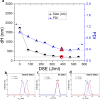Effective delivery of sonication energy to fast settling and agglomerating nanomaterial suspensions for cellular studies: Implications for stability, particle kinetics, dosimetry and toxicity
- PMID: 29479575
- PMCID: PMC5823521
- DOI: 10.1016/j.impact.2017.12.002
Effective delivery of sonication energy to fast settling and agglomerating nanomaterial suspensions for cellular studies: Implications for stability, particle kinetics, dosimetry and toxicity
Abstract
Typical in vitro assays used for high throughput toxicological screening and measuring nano-bio interactions are conducted by pipetting suspensions of engineered nanomaterials (ENMs) dispersed in nutrient-rich culture media directly onto cells. In order to achieve fairly monodisperse and stable suspensions of small agglomerates, ultrasonic energy is usually applied to break apart large agglomerates that can form upon suspension in liquid. Lack of standardized protocols and methods for delivering sonication energy can introduce variability in the ENM suspension properties (e.g. agglomerate size, polydispersity, suspension stability over time), and holds significant implications for in vitro dosimetry, toxicity, and other nano-bio interactions. Careful assessment of particle transformations during dispersion preparation and sonication is therefore critical for accurate interpretation of in vitro toxicity studies. In this short communication, the difficulties of preparing stable suspensions of rapidly settling ENMs are presented. Furthermore, methods to optimize the delivery of the critical sonication energy required to break large agglomerates and prepare stable, fairly monodispersed suspensions of fast settling ENMs are presented. A methodology for the efficient delivery of sonication energy in a discrete manner is presented and validated using various rapidly agglomerating and settling ENMs. The implications of continuous vs. discrete sonication on average hydrodynamic diameter, and polydispersity was also assessed for both fast and slow settling ENMs. For the rapidly agglomerating and settling ENMs (Ag15%/SiO2, Ag and CeO2), the proposed discrete sonication achieved a significant reduction in the agglomerate diameter and polydispersity. In contrast, the relatively slow agglomerating and settling Fe2O3 suspension did not exhibit statistically significant differences in average hydrodynamic diameter or polydispersity between the continuous and discrete sonication approaches. Our results highlight the importance of using the proposed material-specific discrete sonication method to effectively deliver the critical sonication energy necessary to reproducibly achieve stable and fairly monodispersed suspensions that are suitable for in vitro toxicity testing.
Keywords: Engineered nanomaterials; agglomeration; dispersion preparation; nanotoxicology; sonication.
Figures


Similar articles
-
An integrated approach for the in vitro dosimetry of engineered nanomaterials.Part Fibre Toxicol. 2014 May 1;11:20. doi: 10.1186/1743-8977-11-20. Part Fibre Toxicol. 2014. PMID: 24885440 Free PMC article.
-
Implications of in vitro dosimetry on toxicological ranking of low aspect ratio engineered nanomaterials.Nanotoxicology. 2015;9(7):871-85. doi: 10.3109/17435390.2014.986670. Epub 2015 Sep 4. Nanotoxicology. 2015. PMID: 25672815 Free PMC article.
-
Interactions of engineered nanomaterials in physiological media and implications for in vitro dosimetry.Nanotoxicology. 2013 Jun;7(4):417-31. doi: 10.3109/17435390.2012.666576. Epub 2012 Mar 20. Nanotoxicology. 2013. PMID: 22393878 Free PMC article.
-
Investigating the impact of the dispersion protocol on the physico-chemical identity and toxicity of nanomaterials: a review of the literature with focus on TiO2 particles.Part Fibre Toxicol. 2025 May 13;22(1):11. doi: 10.1186/s12989-025-00627-8. Part Fibre Toxicol. 2025. PMID: 40361208 Free PMC article. Review.
-
Nanomaterial toxicity testing in the 21st century: use of a predictive toxicological approach and high-throughput screening.Acc Chem Res. 2013 Mar 19;46(3):607-21. doi: 10.1021/ar300022h. Epub 2012 Jun 7. Acc Chem Res. 2013. PMID: 22676423 Free PMC article. Review.
Cited by
-
Safer-by-design flame-sprayed silicon dioxide nanoparticles: the role of silanol content on ROS generation, surface activity and cytotoxicity.Part Fibre Toxicol. 2019 Oct 29;16(1):40. doi: 10.1186/s12989-019-0325-1. Part Fibre Toxicol. 2019. PMID: 31665028 Free PMC article.
-
Effects of sonication on particle dispersions from a size, biodissolution, cytotoxicity and transferred dose perspective - a case study on nickel and nickel oxide particles.PLoS One. 2025 May 9;20(5):e0323368. doi: 10.1371/journal.pone.0323368. eCollection 2025. PLoS One. 2025. PMID: 40344085 Free PMC article.
-
Toxicity assessment of metal oxide nanomaterials using in vitro screening and murine acute inhalation studies.NanoImpact. 2020 Apr;18:100214. doi: 10.1016/j.impact.2020.100214. Epub 2020 Feb 20. NanoImpact. 2020. PMID: 32968700 Free PMC article.
-
Effects of ingested nanocellulose and nanochitosan materials on carbohydrate digestion and absorption in an in vitro small intestinal epithelium model.Environ Sci Nano. 2021 Sep 1;8(2):2554-2568. doi: 10.1039/d1en00233c. Epub 2021 Jul 20. Environ Sci Nano. 2021. PMID: 34840801 Free PMC article.
-
An In Vitro Dosimetry Tool for the Numerical Transport Modeling of Engineered Nanomaterials Powered by the Enalos RiskGONE Cloud Platform.Nanomaterials (Basel). 2022 Nov 8;12(22):3935. doi: 10.3390/nano12223935. Nanomaterials (Basel). 2022. PMID: 36432221 Free PMC article.
References
-
- McClements DJ, Xiao H, Demokritou P. Physicochemical and colloidal aspects of food matrix effects on gastrointestinal fate of ingested inorganic nanoparticles. Adv Colloid Interface Sci. 2017;246:165–180. - PubMed
-
- Rodrigues SM, Demokritou P, Dokoozlian N, Ogilvie Hendren C, Karn B, Mauter MS, Sadik OW, Sfarpour M, Unrine JM, Viers J, Welle P, White JC, Wiesner MR, Lowry GV. Nanotechnology for sustainable food production: promising opportunities and scientific challenges. Environ Sci-Nano. 2017;4:767–781.
Grants and funding
LinkOut - more resources
Full Text Sources
Other Literature Sources
